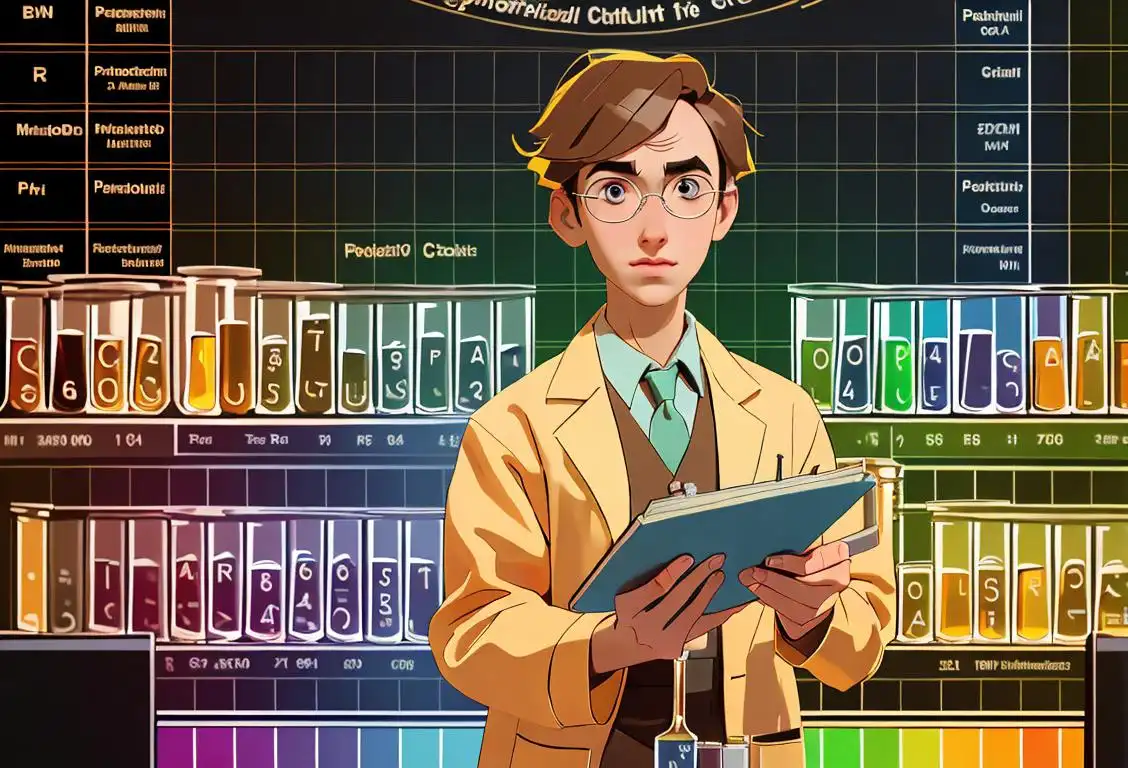National Periodic Table Day

Hold on to your electrons folks, because today we're diving into the deep end of the science pool! That's right, it's National Periodic Table Day, the day we celebrate Mendeleev's creation like it's a rock concert, only with fewer guitar solos and more chemistry.
When is Periodic Table Day?
It's national periodic table day on the 7th February.
A Brief History of National Periodic Table Day
In the grand old year of 1869, Dmitri Mendeleev, a Russian chemist and inventor, took it upon himself to wrangle all the known elements into an organized table. This was not just your average Tuesday, folks! This was the birth of the Periodic Table of Elements and it was nothing short of a scientific revolution. Fast forward to the present, and we see the tribute to Mendeleev's efforts in the form of National Periodic Table Day, typically celebrated on February 7th.
The Day on the Web
Thankfully, the internet has given us much more than just cat videos and endless memes. It also helps us celebrate National Periodic Table Day in molecularly spectacular ways! Our data shows fanfare for this day escalating every year, with an all-time high of 2520 online mentions recorded on February 7, 2017. Isn't it beautiful to see the internet come together over the shared love of science?
How to Celebrate
There are plenty of wholesome and fun ways to join in! You could make your very own periodic table with cookies (and eat them too, of course), host a virtual chemistry quiz or, if you're feeling adventurous, dress up as your favorite element (Gold level glamor, anyone?)
History behind the term 'Periodic Table'
1661
Discovery of the First Element
In the year 1661, the concept of elements took its first step towards the development of the periodic table. Robert Boyle, an Irish chemist, coined the term 'element' to describe substances that could not be broken down further. He identified them as the building blocks of matter.
1789
First Attempt at Classification
In 1789, Antoine Lavoisier, a French chemist, presented the first systematic attempt at classifying elements. He grouped substances into metals and non-metals and identified several gases as elements. Although his classification did not resemble the modern periodic table, it laid the groundwork for future developments.
1817
First Triadic Classification
Johann Wolfgang Döbereiner, a German chemist, proposed the first triadic classification of elements in 1817. He noticed that certain groups of three elements exhibited similar properties. For example, chlorine, bromine, and iodine had comparable chemical behavior. This observation provided early insights into periodicity.
1829
Law of Triads
In 1829, Johann Wolfgang Döbereiner expanded on his triadic classification and formulated the Law of Triads. He observed that the atomic weight of the middle element in a triad was roughly the average of the other two. Although this law was later found to have exceptions, it contributed to the understanding of patterns among elements.
1864
Predicting New Elements
John Newlands, an English chemist, proposed the Law of Octaves in 1864. He arranged elements in order of increasing atomic weight and noticed that every eighth element exhibited similarities. This periodic repetition allowed him to predict the existence and properties of undiscovered elements, including germanium.
1869
Mendeleev's Periodic Table
Dmitri Mendeleev, a Russian chemist, published the first widely recognized periodic table of elements in 1869. He arranged elements by increasing atomic weight and grouped them based on similarities in their properties. He also left gaps for yet-to-be-discovered elements, accurately predicting their properties and even their existence. Mendeleev's periodic table revolutionized the field of chemistry.
1913
Modern Understanding with Atomic Number
In 1913, Henry Moseley, an English physicist, introduced the concept of atomic number. He discovered that the properties of elements depended on their atomic number rather than their atomic weight. The modern periodic table, based on atomic number, explains the periodicity observed with much greater accuracy and provided a robust foundation for elemental classification.
Did you know?
Did you know Mendeleev’s Periodic table was so ahead of its time, it even had spaces for elements that were yet to be discovered? Now that's one way to stay ahead of the game!Tagged
awareness fun rememberance education scienceFirst identified
7th February 2016Most mentioned on
7th February 2017Total mentions
2520Other days
Periodic Table Day
Mole Day
Fossil Day
Pencil Day
College Signing Day
Stem Day
Dna Day
Education Day
Girl Child Day
Bestfriends Day








